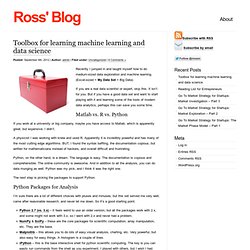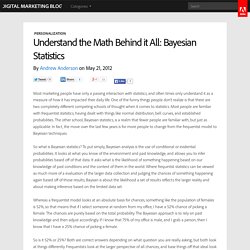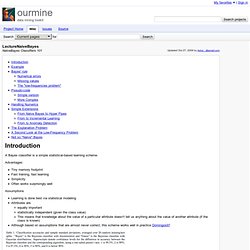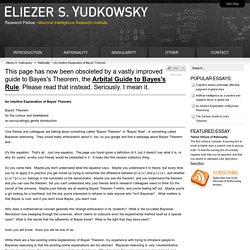

BigML - Machine Learning Made Easy. Ross's Blog » Blog Archive » Toolbox for learning machine learning and data science. Posted: September 6th, 2012 | Author: admin | Filed under: Uncategorized | 9 Comments » Recently I jumped in and taught myself how to do medium-sized data exploration and machine learning.

(Excel-sized < My Data Set < Big Data) If you are a real data scientist or expert, skip this. It isn’t for you. But if you have a good data set and want to start playing with it and learning some of the tools of modern data analytics, perhaps this can save you some time. Matlab vs. If you work at a university or big company, maybe you have access to Matlab, which is apparently great, but expensive.
A physicist I was working with knew and used R. Python, on the other hand, is a dream. The next step is picking the packages to support Python. Python Packages for Analysis I’m sure there are a lot of different choices with pluses and minuses, but this set served me very well, came after reasonable research, and never let me down. Bayes' Theorem Illustrated (My Way) (This post is elementary: it introduces a simple method of visualizing Bayesian calculations.

In my defense, we've had other elementary posts before, and they've been found useful; plus, I'd really like this to be online somewhere, and it might as well be here.) I'll admit, those Monty-Hall-type problems invariably trip me up. Or at least, they do if I'm not thinking very carefully -- doing quite a bit more work than other people seem to have to do. What's more, people's explanations of how to get the right answer have almost never been satisfactory to me. If I concentrate hard enough, I can usually follow the reasoning, sort of; but I never quite "see it", and nor do I feel equipped to solve similar problems in the future: it's as if the solutions seem to work only in retrospect.
Minds work differently, illusion of transparency, and all that. Trivial Artificial Neural Network in Assembly Language. Source code for this article may be found here.

Note for nerds: The code shown in this article may be incomplete and may not contain all the security checks you would usually perform in your code as it is given here for demonstration purposes only. Downloadable source code may contain bugs (there is no software without bugs at all). It is provided as is without any warranty. You may use and redistribute it as you wish while mentioning this site and the author. I was recently digging through my sources and came across a small ANN (artificial neural network) library I wrote several months ago in 64 bit Intel Assembly language (FASM syntax) and decided to share it with my respected readers hoping that it may be useful in some cases. Sidewinder Events - Raver Baby. Understand the Math Behind it All: Bayesian Statistics. Most marketing people have only a passing interaction with statistics, and often times only understand it as a measure of how it has impacted their daily life.

One of the funny things people don’t realize is that there are two completely different competing schools of thought when it comes to statistics. Most people are familiar with frequentist statistics, having dealt with things like normal distribution, bell curves, and established probabilities. The other school, Bayesian statistics, is a realm that fewer people are familiar with, but just as applicable. In fact, the move over the last few years is for more people to change from the frequentist model to Bayesian techniques. So what is Bayesian statistics? Whereas a frequentist model looks at an absolute basis for chances, something like the population of females is 52%, so that means that if I select someone at random from my office, I have a 52% chance of picking a female. Hilary Mason - Machine Learning for Hackers. LectureNaiveBayes - ourmine - NaiveBayes Classifiers 101 - data mining toolkit.
A Bayes classifier is a simple statistical-based learning scheme.

Advantages: Tiny memory footprint Fast training, fast learning Simplicity Often works surprisingly well.
Bayes' Theorem. An Intuitive Explanation of Bayes' Theorem Bayes' Theorem for the curious and bewildered; an excruciatingly gentle introduction.

Your friends and colleagues are talking about something called "Bayes' Theorem" or "Bayes' Rule", or something called Bayesian reasoning. They sound really enthusiastic about it, too, so you google and find a webpage about Bayes' Theorem and... It's this equation. That's all. So you came here. Why does a mathematical concept generate this strange enthusiasm in its students?
Soon you will know. While there are a few existing online explanations of Bayes' Theorem, my experience with trying to introduce people to Bayesian reasoning is that the existing online explanations are too abstract. Or so they claim. And let's begin. Simple Explanation of Bayesian Logic. OK.

Naive Bayes is ridiculously simple. [EDIT: Oops, it looks like I myself managed to get it backward on the first write! Whaps self in forehead. Rewritten now.] Let's say your user likes 40 items and hates 60 items. Then it turns out that, of the 40 items the user liked, 4 of these or 10% are tagged "green", and of the 60 items the user hated, 12 of these or 20% are marked "green". 0.1:0.2 (Given that an item is hated, the user is twice as likely to tag it "green" than if the item is liked.) Then it turns out that of the 40 items the user liked, 8 or 1/5 are tagged "red", and of the 60 items the user hated, 3 or 1/20 are tagged "red.
Scaling/Big Data/Distributed/Etc | Technology Topics. Computer Vision/Object Recognition | Technologies. GraphLab: A New Parallel Framework for Machine Learning.